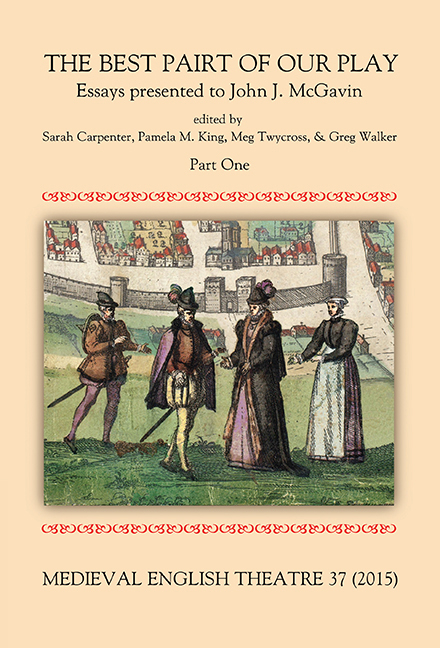Book contents
- Frontmatter
- Contents
- Epigraph
- Editorial
- In honorem John J. McGavin
- John J. McGavin: Bibliography
- The Places of Foolery: Robert Armin and fooling in Edinburgh
- George Bannatyne's ‘Sertane Mirry Interludis’, and Sir David Lyndsay's play
- The Linlithgow Interlude of 1540 and Lyndsay's Satire of the Thrie Estaitis
- Stage Directions in Lyndsay's Ane Satire of the Thrie Estaits
- The Dramatic Voice of William Dunbar
- How to Track a Bear in Southwark: a learning module
- The Digby Mary Magdalen in Performance: a merry peripeteia
- ‘Thus am I Rent on Rode’: taking apart the Towneley Crucifixion
- The Second Shepherds' Play: a play for the Christmas season
- ‘They did not come out of an Abbey in Lancashire’: Francis Douce and the manuscript of the Towneley Plays
- EDITORIAL BOARD (2015)
The Linlithgow Interlude of 1540 and Lyndsay's Satire of the Thrie Estaitis
Published online by Cambridge University Press: 05 March 2016
- Frontmatter
- Contents
- Epigraph
- Editorial
- In honorem John J. McGavin
- John J. McGavin: Bibliography
- The Places of Foolery: Robert Armin and fooling in Edinburgh
- George Bannatyne's ‘Sertane Mirry Interludis’, and Sir David Lyndsay's play
- The Linlithgow Interlude of 1540 and Lyndsay's Satire of the Thrie Estaitis
- Stage Directions in Lyndsay's Ane Satire of the Thrie Estaits
- The Dramatic Voice of William Dunbar
- How to Track a Bear in Southwark: a learning module
- The Digby Mary Magdalen in Performance: a merry peripeteia
- ‘Thus am I Rent on Rode’: taking apart the Towneley Crucifixion
- The Second Shepherds' Play: a play for the Christmas season
- ‘They did not come out of an Abbey in Lancashire’: Francis Douce and the manuscript of the Towneley Plays
- EDITORIAL BOARD (2015)
Summary
The exact relationship between the mysterious ‘Interlude’ played before James V in Linlithgow Palace in 1540, of which we have only a description, and Sir David Lyndsay's Satire of the Thrie Estaitis of 1552 and 1554 (hereafter, the Satire), for which we have two distinct surviving texts, has long been a matter for debate among scholars. Lyndsay's first modern editor, Douglas Hamer, argued in the 1930s that the Interlude was an earlier version of the Satire, but subsequent critics have not always agreed. Angus Calder thought the Interlude ‘had one or two features in common with the Satire’, and John MacQueen that it ‘was only generally similar to the … [text] which has survived’. Perhaps most powerfully, R.J. Lyall, while acknowledging that ‘the affinities between the interlude and The Thrie Estaitis are striking enough for the former to be widely accepted as the original version of the latter’, was nonetheless troubled by the ‘many differences’ he also saw between the two, and so on balance concluded with cautious pessimism that:
While it may well be that Lindsay wrote the Linlithgow interlude … the differences between the lost play and The Thrie Estaitis are so great that it would be extremely rash to associate any specific passage of the extant play with this earlier piece.
What I want to do here is to revisit the evidence to test the relationship between what we know about the two plays. My conclusion is the rash one that we can map very closely substantial parts of the 1552–1554 text onto the description of the Interlude, revealing close and detailed continuities between both the political concerns and the suggested solutions represented in each, to the point where it seems beyond reasonable doubt that Lyndsay was the author of the Interlude as well as the Satire, and that the former is closely related to the latter.
But, as Lyall observes, there are also differences between the two plays, in terms both of their content and dramatic structure. The evidence, I will argue, suggests that these differences are less significant than previously thought, however, and that Lyndsay was determined to explore many of the same social and cultural problems in 1552–1554 which he had identified in 1540; but, as a result of changing circumstances and a very different intended audience, he chose to pursue them through significantly different dramatic strategies.
- Type
- Chapter
- Information
- Medieval English Theatre 37The Best Pairt of our Play. Essays presented to John J. McGavin. Part I, pp. 41 - 56Publisher: Boydell & BrewerPrint publication year: 2015



